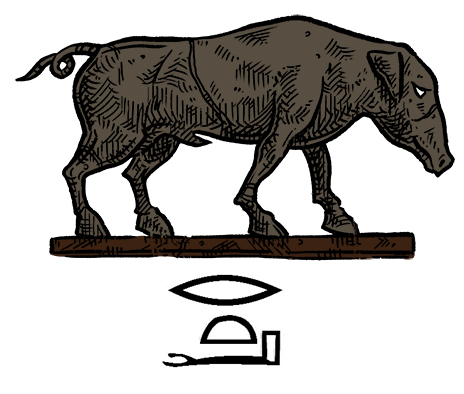Difference between revisions of "Aryt"
Occultwiki (talk | contribs) (Created page with "300px|thumb|Aryt as depicted on the Dendera B Zodiac '''Aryt''' is the 31st decan of the main decanal stars of Egyptian astrology....") |
Occultwiki (talk | contribs) |
||
| Line 16: | Line 16: | ||
The Dendera B [[zodiac]] ceiling depicts this decan as a male pig. This is derived from a story in the Coffin Texts involving [[Horus]] and [[Set]]. After Horus' eye is injured, [[Ra]] tells him to cover the eye and look at a black pig. Doing so causes Horus' good eye to also become injured because Set had transformed himself into a pig and projected the wound. For this reason, Ra declared that pigs are detestable and all his followers should consider the animal an abomination. | The Dendera B [[zodiac]] ceiling depicts this decan as a male pig. This is derived from a story in the Coffin Texts involving [[Horus]] and [[Set]]. After Horus' eye is injured, [[Ra]] tells him to cover the eye and look at a black pig. Doing so causes Horus' good eye to also become injured because Set had transformed himself into a pig and projected the wound. For this reason, Ra declared that pigs are detestable and all his followers should consider the animal an abomination. | ||
Egyptologist Bernard Arquier believes this is a reference to the | Egyptologist Bernard Arquier believes this is a reference to the [[moon|new moon]], when the sky would have been darkest and Horus was absent. | ||
Revision as of 19:16, 24 January 2023
Aryt is the 31st decan of the main decanal stars of Egyptian astrology. The decan has its heliacal rise during the week of III Shemu 1-10 in the Egyptian calendar. Its name is translated as "roll of papyrus."
Name
“The Thousands” may seem like a strange name for a decan, but it represents someone who has received respect and admiration from a large group of people. It may help to know that the astronomical identity of this decan is most likely the Pleiades, a cluster of just over 1,000 stars. Only about 14 of these stars can be seen by the naked eye, but the ancient Egyptians gave this decan a name which turned out to be incredibly accurate.
Divination meaning
The Egyptian Star Oracle connects this decan to writing or a person's legacy.
Characteristics
According to the Naos of the Decades, this decan has several functions, including causing skin rashes and carrying out the death sentences issued by Thoth-Shu across the four cardinal directions in foreign lands “among those on land and in the water.” In spell 474 of the Coffin Texts, the deceased, who is nearing the point of joining the gods, states, “See me, a living soul, who releases the willow. See, I have come with my guard-beam in my hand and my roll of papyrus in my hand. I have come that I may enter the stairs to heaven.”
Its minerals are listed on the Dendera D zodiac as granite and gold.
Depiction as a Set-pig
The Dendera B zodiac ceiling depicts this decan as a male pig. This is derived from a story in the Coffin Texts involving Horus and Set. After Horus' eye is injured, Ra tells him to cover the eye and look at a black pig. Doing so causes Horus' good eye to also become injured because Set had transformed himself into a pig and projected the wound. For this reason, Ra declared that pigs are detestable and all his followers should consider the animal an abomination.
Egyptologist Bernard Arquier believes this is a reference to the new moon, when the sky would have been darkest and Horus was absent.
| The Decans of Egyptian Astrology | ||
|---|---|---|
| Previous Decan | This Decan | Next Decan |
| Khau | Aryt | Remen Hery Sah |
